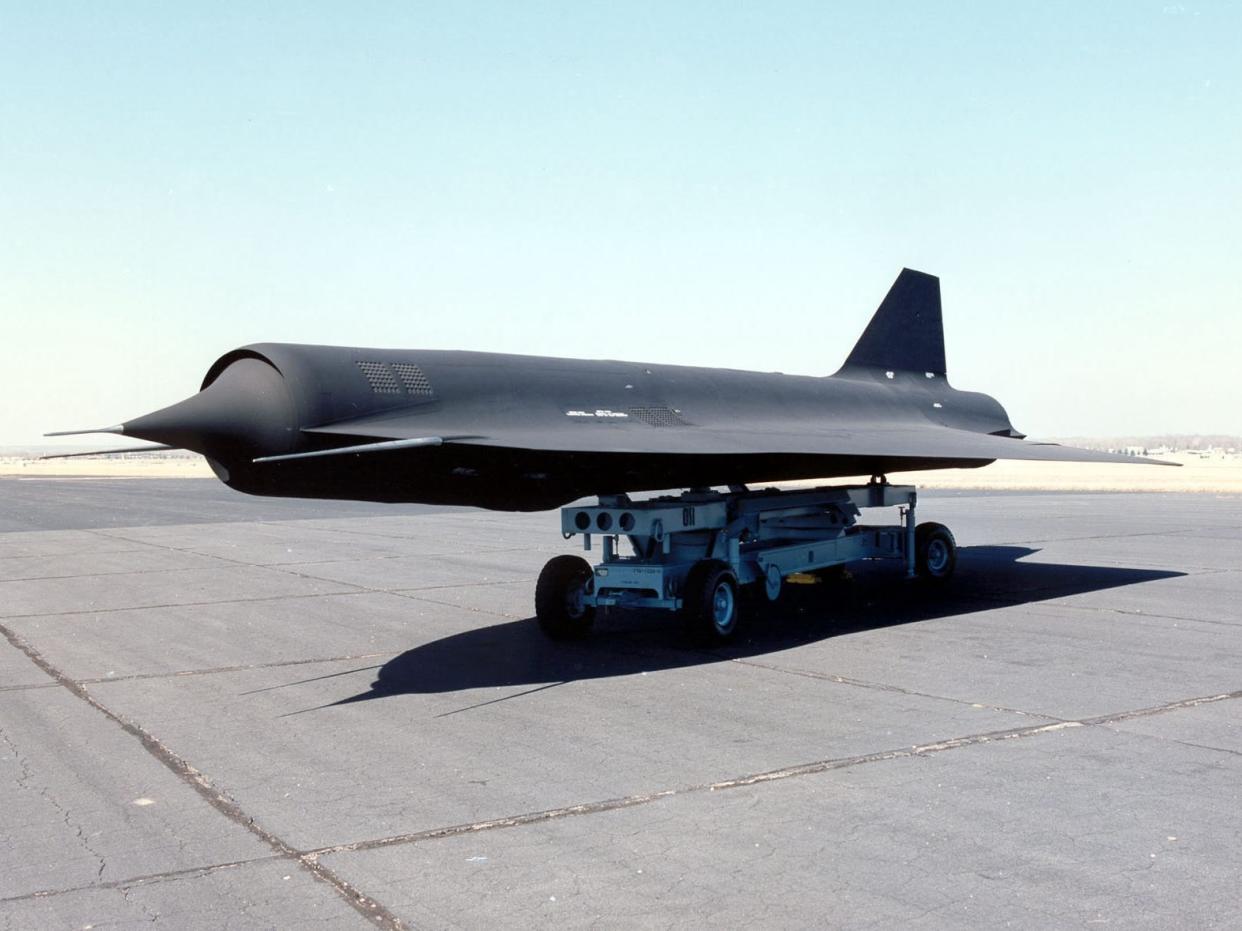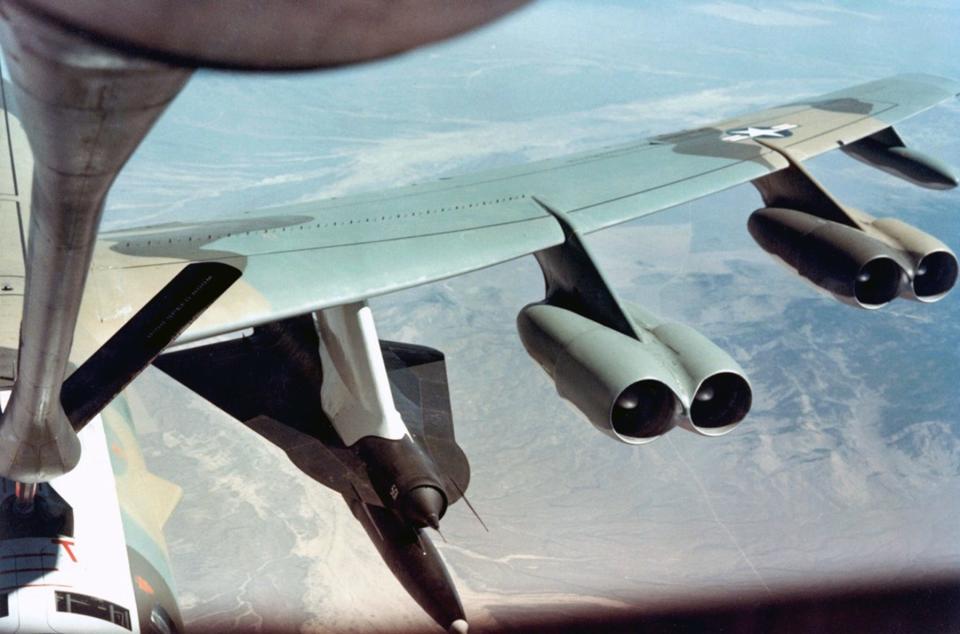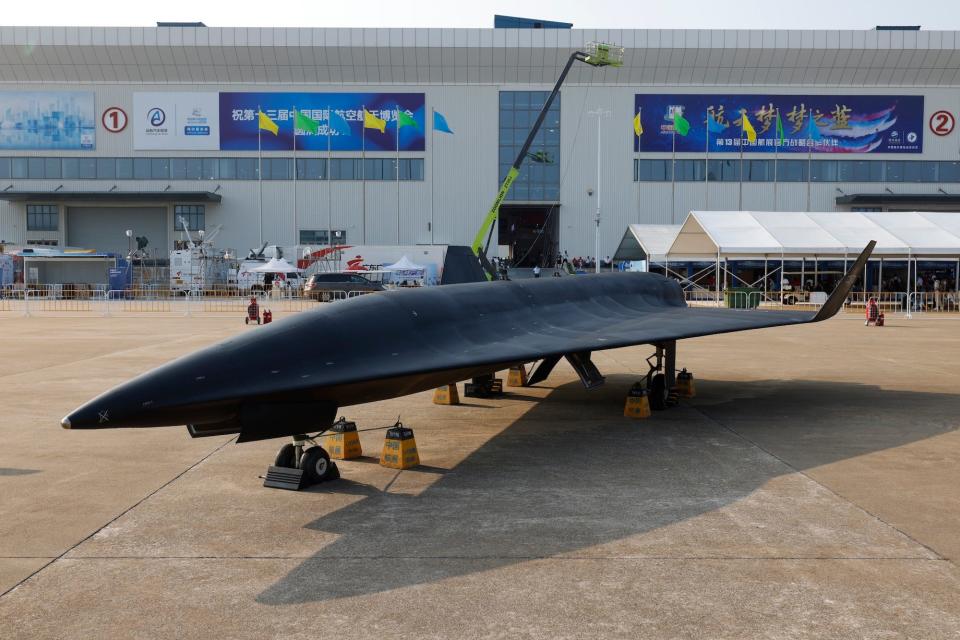China's latest supersonic spy drone looks a lot like the Lockheed D-21 that crashed there in 1971

Lockheed developed a spy drone in the 1960s that crashed in China.
China recently debuted a supersonic drone that bears a striking resemblance to Lockheed's D-21.
The D-21's urgent development was marked by ambition and tragedy.
On March 20, 1971, a specially modified US Air Force B-52 bomber from the 4200th Support Squadron took off from Andersen Air Force Base in Guam carrying a unique aircraft mounted under its wing.
The aircraft, shaped like a dart and painted black, was a D-21 supersonic reconnaissance drone. It was to be the fourth such drone to conduct aerial reconnaissance of China's Lop Nor nuclear test site in northwestern China, and despite its sophistication, it would crash into the very country it was intended to spy on.
Created by the renowned Lockheed Corporation, the D-21 was the most advanced unmanned aircraft of its time. Intended to bridge a gap between burgeoning satellite technology and manned reconnaissance flights, the drone's development was filled with ambition, urgency, and tragedy.
Ultimately unsuccessful, the drone would be relegated to the annals of aviation history if not for the appearance of a strikingly similar Chinese drone unveiled at a recent military parade. This delta-shaped drone of similar size also requires being launched by a mothership. But Chinese engineers claim advances that go much farther than the D-21, reaching 30 miles into the atmosphere and speeds up to Mach 6.
This is what we know about the high-flying Chinese spy drone and the D-21 upon which it could be based.
An urgent need
The origins of the D-21 start in 1960, when Francis Gary Powers and his U-2 spy plane were shot down over the Soviet Union by a Soviet surface-to-air missile. The incident pushed President Dwight Eisenhower to discontinue all manned reconnaissance flights over the Soviet Union to avoid future casualties and embarrassments.
But the need to surveil Soviet military sites was still vital, and while reconnaissance satellites were starting to be launched into space, the technology was nascent. Satellites carried a limited amount of film despite being in orbit for days, had limited repositioning ability, and were not as available for short-notice launches in emergencies compared to manned aircraft.
A faster and higher-flying successor to the U-2, the A-12, was in development. However, as a conventional aircraft, it still had to be manned, and the White House and CIA alike were both reluctant to risk the capture of another pilot, especially if it also meant losing an even more advanced aircraft in the process.
Consequently, the CIA needed a stopgap solution until the satellite programs matured. In 1962, the Central Intelligence Agency approached Lockheed's Skunk Works division (which created the U-2 and the A-12) for such a solution.
High altitude, high speed
Lockheed's solution was to create an unmanned high-altitude high-speed reconnaissance aircraft with similar capabilities as the A-12, but much smaller. Originally designated as the Q-12, the drone utilized a delta wing design, had a wingspan of 19 feet, and measured 42 feet long.
It was powered by a Marquardt RJ43-MA-20S4 ramjet engine that ran the entire length of the aircraft. Capable of producing 11,500 lbs. of thrust, the engine gave the drone a top speed of Mach 3.3, and enabled it to reach an altitude of 95,000 feet. The D-21's range, meanwhile, was over 3,000 miles.
Because it was powered by a ramjet engine, the drone had to be launched from a mothership once it reached a speed where the ramjet could be activated. A modified A-12 was judged to be the best candidate. Redesignated as the M-21, the jet would carry the drone, redesignated as the D-21, on its fuselage, then release it once it reached a speed where the ramjet could be activated.
Once released, the D-21 would fly a pre-programmed route utilizing an internal navigation system to the area of interest, where it would take photos.
Once taken, the D-21 would fly to a designated area, eject its film cannister, then self-destruct. The film cannister, meanwhile, would be snatched from the sky as it parachuted down by a waiting JC-130B, or be collected by a Navy vessel.
Dubbed Project Tagboard, the first carry test occurred on December 22, 1964, with the first separation and flight test occurring on March 6, 1966. Two more largely successful tests followed.
But the fourth flight test, on July 30, ended in tragedy when the D-21 collided with the M-21 after release, destroying both aircraft. Pilot Bill Park and Launch Control Officer Ray Torrick successfully ejected, but Torrick's flight suit was likely torn in the process, leading to it filling with water when both men landed in the ocean, causing him to drown.
After the crash, it was decided that using M-21s as a mothership was too dangerous. Instead, a modified B-52H would be used, carrying up to two drones under its wings. As the bomber was unable to fly at the speed required to activate the D-21's scramjet engine, a 44-foot rocket booster was attached underneath it. After release, the booster would ignite to bring the D-21 to the required speed, then detach after its scramjet came online.

Senior Bowl
Now dubbed Project Senior Bowl, the new system was tested multiple times between September 1967 and early 1969 with mixed results. The D-21's first fully successful test occurred on June 16, 1968, which saw it fly some 3,000 miles at 90,000 feet.
Despite its spotty success record, the drone was approved for limited service in 1969. Flying out of Andersen Air Force Base, the D-21s were given the task of spying on China's Lop Nor nuclear test site, where China had detonated its first nuclear weapon five years earlier.
But while the tests had mixed results, the missions were all failures.
The first mission, on November 9, 1969, was perhaps the worst. After launching from its mothership and reaching Lop Nor, contact with the D-21 was lost, and it disappeared.
In fact, the drone continued flying all the way into the Soviet Union, and crashed in the Siberian wilderness. With the wreckage recovered, Soviet engineers drew up plans for a reverse-engineered copy called the Voron, but the project was never pursued.
After more than a year of further testing and preparation the second mission was flown on December 16, 1970. The D-21 launched successfully, reached Lop Nor, took its photographs, and arrived at the return point, but the film canister's parachute didn't deploy properly after ejection, and it was lost at sea.
The third mission, on March 4, 1971, proceeded similarly. The film canister's parachute deployed successfully, but the JC-130B failed to recover it before it splashed into the water. A Navy destroyer attempted to recover the floating canister, but accidentally collided with it, causing it to sink.
The fourth and final mission two weeks later was a complete failure, with the D-21 crashing into China's southwestern Yunnan province while en route to Lop Nor. The drone was recovered by the Chinese, and is on display at the Chinese Aviation Museum in Beijing.
With Senior Bowl resulting in four operational failures, and with each drone costing at least $2.5 million, the D-21 program became hard to justify — especially as satellites were becoming more advanced.
Consequently, the program was canceled in July 1971.
Of the 38 D-21's built, 21 had been used in tests or operations. The remaining D-21s were put into storage, and eventually made their way to the boneyard at Davis-Monthan Air Force Base in Tucson, Arizona.
Apart from the crashed model at the Chinese Aviation Museum, 11 D-21s are on display in the United States.

A Chinese copy?
The D-21 had largely faded from public memory until 2019, when, at the military parade commemorating the 70th Anniversary of the People's Republic of China on October 1, China unveiled a similar-looking drone.
Dubbed the WZ-8, the drone is a delta-wing design, about 37 feet long, and has a wingspan of 22 feet. Instead of a scramjet running the length of the body, it is powered by two rocket motors.
Like the D-21, the WZ-8 must be launched by a mothership during flight — specifically an H-6M, a version of the H-6 strategic bomber modified to carry cruise missiles on external hardpoints.
Chinese media has reported that the WZ-8 is capable of flying 160,000 feet and as fast as Mach 6. Its sensor suite reportedly includes a daylight electro-optical sensor and a synthetic aperture radar.
Documents reportedly leaked from US intelligence sources last year revealed that China has "almost certainly" established its first operational WZ-8 unit.
One document, alleged to originate from the US National Geospatial-Intelligence Agency, claims that the unit is based at Liuan Airfield, and that its missions could include high-altitude reconnaissance flights of the South Korean coast and virtually all of Taiwan.
According to the document, the drone would be released from its mothership just off the northern or eastern Chinese coast, execute its mission, then return and land at Chinese coastal airfields, whereupon it would be loaded back on an H-6M bomber and return to Liuan. The document lists the WZ-8 as being capable of flying up to 100,000 feet at Mach 3.
It has been separately speculated that the WZ-8 could be used to track US carrier battle groups in the Pacific in real time.
Subsequent reporting confirmed the presence of at least one WZ-8 at Liuan Airfield. The base, which is reportedly home to the 29th Air Regiment of the People's Liberation Army Air Force's 10th Bomber Division, has been receiving extensive upgrades since at least early 2019.
Benjamin Brimelow is a freelance journalist covering international military and defense issues. He holds a master's degree in Global Affairs with a concentration in international security from the Fletcher School of Law and Diplomacy. His work has appeared in Business Insider and the Modern War Institute at West Point.
Read the original article on Business Insider

